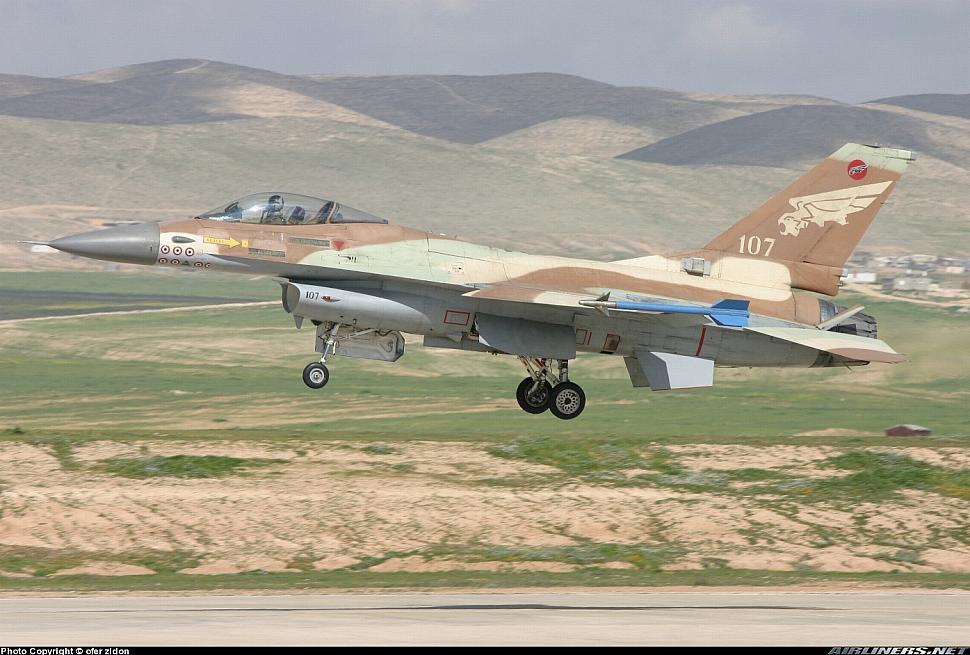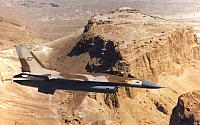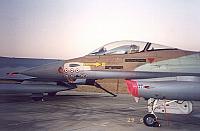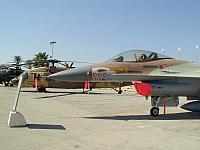Fighter Jet News
F-16 Fighting Falcon News
Famous MiG-killer retiring from IDF service
February 12, 2015 (by
Lieven Dewitte) -
With an all-time high of seven dogfight victories under its wings and one nuclear reactor bombing, Israel Air Force F-16A Netz No. 107 is being retired and will go on display in the IAF Museum at the Hatzerim air base in the Negev.
The history of the jet in the Israeli Air Force began with the delivery under the Peace Marble I Foreign Military Sales program. It was part of a 75-strong fleet that was originally intended for the Imperial Iranian Air Force. The demise of the Shah in 1979 and the consequent rise of the Islamic fundamentalist regime however caused these planes to be diverted to Israel. They had a number of internal changes that were unique to Israeli requirements, including the fitting of chaff/flare dispensers.
The first four F-16s, known as Netz (Hawk) in IDFAF service and wearing standard sand/brown/green camouflage colors, arrived in at Israel's Ramat David Air Base in on June 18th 1980, after an 11 hour delivery flight. IOC was achieved a few weeks later. The aircraft was originally built as a block 5 but has been converted to a block 10 before delivery.
On June 7, 1981, Fighting Falcon No. 107 participated in the IAF's strike on the Iraqi nuclear reactor Osirak, with former Military Intelligence chief Major General (ret.) Amos Yadlin at the controls.
In the following years the jet became the highest scoring individual F-16, downing a total of seven enemy aircraft - a record unmatched even by the most advanced F-16 models in use today.
The Netz 107 began its history of successful missions on April 21, 1982 when downed a Syrian MiG-23 with a rocket fired by Colonel in reserves Zeev Raz, who led the bombing of the Iraqi reactor a year before.
On June 9, 1982, during the First Lebanon War, the famed F-16 shot down two Syrian MiG-23 planes. One of the two rockets that led to the Syrian planes' demise was launched by former Israel Air Force commander in reserves Eliezer Shakedi and the other rocket was fired by Colonel Eitan Sativa.
On June 11, 1982, the No. 107 F-16 jet had its historical day after it shot down two MiG-23 Syrian jets, a Soviet made Sukhoi Su-17, and an Aérospatiale Gazelle helicopter all in one blow by Colonel Eitan Sativa.
The jet bears 6.5 Syrian kill markings (one was a joint interception with another Israeli fighter) and a green triangle from operation Opera.
No. 107 was finally retired from operational duty at the end of 2014, after serving since 1995 as a training aircraft for flight cadets; and in light of its impressive achievements, the aircraft underwent a facelift and now stands proud at the IAF Museum in Hatzerim.
The first four F-16s, known as Netz (Hawk) in IDFAF service and wearing standard sand/brown/green camouflage colors, arrived in at Israel's Ramat David Air Base in on June 18th 1980, after an 11 hour delivery flight. IOC was achieved a few weeks later. The aircraft was originally built as a block 5 but has been converted to a block 10 before delivery.
On June 7, 1981, Fighting Falcon No. 107 participated in the IAF's strike on the Iraqi nuclear reactor Osirak, with former Military Intelligence chief Major General (ret.) Amos Yadlin at the controls.
In the following years the jet became the highest scoring individual F-16, downing a total of seven enemy aircraft - a record unmatched even by the most advanced F-16 models in use today.
The Netz 107 began its history of successful missions on April 21, 1982 when downed a Syrian MiG-23 with a rocket fired by Colonel in reserves Zeev Raz, who led the bombing of the Iraqi reactor a year before.
On June 9, 1982, during the First Lebanon War, the famed F-16 shot down two Syrian MiG-23 planes. One of the two rockets that led to the Syrian planes' demise was launched by former Israel Air Force commander in reserves Eliezer Shakedi and the other rocket was fired by Colonel Eitan Sativa.
On June 11, 1982, the No. 107 F-16 jet had its historical day after it shot down two MiG-23 Syrian jets, a Soviet made Sukhoi Su-17, and an Aérospatiale Gazelle helicopter all in one blow by Colonel Eitan Sativa.
The jet bears 6.5 Syrian kill markings (one was a joint interception with another Israeli fighter) and a green triangle from operation Opera.
No. 107 was finally retired from operational duty at the end of 2014, after serving since 1995 as a training aircraft for flight cadets; and in light of its impressive achievements, the aircraft underwent a facelift and now stands proud at the IAF Museum in Hatzerim.
Additional images:
Related articles:
Forum discussion:
Tags
- Attack on Iraq's nuclear reactor (2006-06-07)
- ()
- F-16 Fighting Falcon news archive
Forum discussion:
- Start a discussion about this article in the F-16.net forum.
Tags




